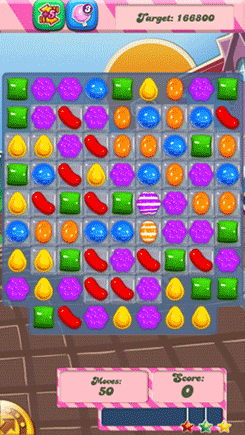Candy Crush: Insanely Addictive Today, but Likely on Borrowed Time
It’s not the prettiest video game ever made and certainly not the most clever, but Candy Crush Saga may be the world’s most addictive.
Psychologists and other cognitive experts say the treat-smashing mobile app, a twist on earlier pattern-matching games, from Bejeweled all the way back to Tetris, grabs players by appealing to some of the human brain’s most deeply rooted desires.


But some also say the game’s appeal contains the seeds of its eventual demise -- a candy crash may be coming for Candy Crush. It would be quite a fall. Some 45 million people a month play regularly, according to AppData. Candy Crush has been one of the most downloaded apps in the Google Play and Apple iTunes stores for months. And it's bringing in an estimated $633,000 a day for publisher King.com, ThinkGaming calculates, for a pace of more than $230 million a year.
The rules are simple. Players must shift a variety of brightly colored candies around a grid to line up at least three of the same treat, causing the candies to explode. With almost 400 levels, and more added all the time by its designer, players never run out of new challenges. The game’s bright colors and soothing music obviously add to the appeal.
But what about this makes Candy Crush impossible to quit? First, much like a Las Vegas slot machine, the game features unpredictable rewards. For instance, candies with special powers pop up or a single move leads to a cascade of other explosions across the whole grid, accompanied by silly sounds and cartoon.
Psychologists call the tactic the partial reinforcement effect. “People keep responding in the absence of reinforcement hoping that another reward is just around the corner,” says Mark Griffiths, director of the International Gaming Research Unit at the psychology department of Nottingham Trent University.
Defeat those friends
Candy Crush also eliminated the time pressure found in most similar games. Instead of racing to finish each level before time expires, players can work at a leisurely pace. The limit is on the number of moves. Run out of moves before a level is completed, and the game offers to give you more -- for a small payment.
Many games maintain rankings of all-time top scores to motivate players to keep playing, but Candy Crush hooks into a user’s social networks on Facebook (FB). That lets players see how they’re doing against their friends, not just the best players in the world. And Candy Crush uses the Facebook connection to remind people to keep playing.
The fact “that players begin competing and comparing themselves to friends further drives their use when they would be able to otherwise reduce it,” says psychologist Adi Jaffe, an expert on addictive behaviors.
At the most fundamental level, Candy Crush taps the brain’s systems for finding patterns. Evolution has honed humans’ ability to find and react to patterns in the environment for thousands of years, whether to find prey when hunting or avoid dangerous situations.
“It’s a task we’re not only very good at, but also innately feel good about,” says Charles Mauro, president of MauroNewmedia and a leading expert on user interface design.
The pleasure from recognizing patterns is enhanced by hints Candy Crush offers. When a player can’t seem to find the next match, the game subtly flashes behind candies that could be shifted to burst. That makes the game easier to master at the start, enhancing its ability to draw in new users.
“It’s been used on everything from targeting schemes for cruise missiles to these goofy little games,” Mauro says. “And it makes the game more approachable early on.”
Birds, slingshots and pigs
Mauro, who has written about the deep appeal of Angry Birds, predicts that Candy Crush won’t be able to stay atop the rankings for much longer, however.
The game itself is free, but whenever a player runs out of moves before completing a level, an offer pops up to buy more moves or special powered extras. For many people, the offers constantly reinforce a sense of inadequacy. “They’re subtly pointing out that you’re not good enough to play, and you have to pay for it,” Mauro says.
Ultimately, pattern-matching games like Candy Crush fail to provide most people with a deep sense of engagement, and the brain eventually tires of constantly looking for patterns, Mauro indicates. Candy Crush may remain popular for a while longer, but that will “level off in a few months or so and then drop like a stone,” he expects.
That falling stone could crush plans for King.com’s parent, Midasplayer International Holding Co., to go public. But game players themselves will do what they always have -- move on to the next hot app no one can put down.
To keep up with all the latest news in tech, follow Aaron Pressman on Twitter and Tumblr.